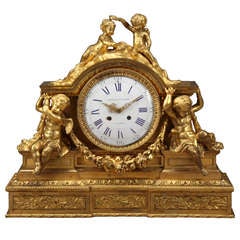Henry Picard Clock
Recent Sales
Antique 19th Century French Napoleon III Mantel Clocks
Bronze, Enamel
Henri Picard for sale on 1stDibs
Henri Picard was a 19th-century gilder who is said to have graced Paris with his stunning furniture and decor from 1831 to 1864. His bronze pieces included exquisitely detailed candelabras, ornate clocks and sculptural table lamps.
Each item cast and gilded by the talented Picard represented the marriage of function and beauty and is a notable example of Napoleon III-style design. Developing from 1852–70, Napoleon III furniture was plush and ornate, matching the fashion for masked balls and socializing in salons.
Picard was particularly known for his artistry — his body of work includes expertly cast gilt bronze (ormolu) mounts for a range of porcelain vessels produced by Sèvres, a maker of exemplary European ceramics for hundreds of years. Picard collaborated with many designers of his day and worked for a firm called Defreville. And while Picard received numerous commissions, his most notable was designing decorative objects for Napoleon III. The pieces are still displayed at the Napoleon III Apartments in the Louvre Museum, Paris.
Picard also designed mantel clocks for the prestigious French clock-making company Raingo Frères. The manufacturer’s clocks are also on display in the Napoleon III Apartments.
On 1stDibs, find antique Henri Picard decorative objects, lighting, case pieces and more.
A Close Look at Napoleon-iii Furniture
Under Napoleon III’s rule, Paris underwent a great rebuilding overseen by Baron Georges-Eugène Haussmann, which created grand avenues and lavish landmarks like the Paris Opera. Antique Napoleon III–style furniture was flamboyant and eclectic. It was also known as Second Empire style since it followed and referenced the Empire style of his uncle Napoleon I.
Developing from 1852–70, Napoleon III furniture was plush and ornate, matching the fashion for masked balls and socializing in salons. It borrowed freely from earlier French styles including Louis XIV, Louis XV and Louis XVI as well as aesthetics from around the world, from antiquity to Asian art. As writer Gustave Claudin remarked in 1867, the country’s architects worked in “a style which one would be tempted to call neo-Greco-Gothico-Pompadour-Pompeian.”
Napoleon III chairs were completely covered with velvet and lined with tassels; pouf footstools invited people to put up their feet. Sofas were upholstered with tapestries, and beds were adorned with gilt bronze and theatrical canopies. The addition of conservatories to homes led to new indoor-outdoor furniture, while the spirit of hygiene promoted by Baron Haussmann inspired bright, floral motifs.
Although the most ostentatious designs were for the elite, as seen in the Napoleon III apartments preserved in the Louvre, where red velvet, gilding and chandeliers create a cacophony of luxury, these trends influenced homes across classes as manufacturing made design increasingly accessible. Papier-mâché furniture allowed for elaborate shapes that would have been difficult to carve in wood. The malleable material was painted with chinoiserie patterns and decorative designs. It was mass-produced by factories such as Jennens and Bettridge with varnishing and mother-of-pearl inlays creating an effect reminiscent of Asian lacquer. (Surfaces that had been “japanned” — a specialty of Jennens and Bettridge — were intended to resemble lacquer work that was created in East Asia.)
Find a collection of antique Napoleon III decorative objects, tables, seating and other furniture on 1stDibs.
Finding the Right Mantel-clocks for You
Personal time-telling devices may have migrated from our pockets to our wrists and finally onto our phones, but despite the convenience of a handheld digital timekeeper, nothing can beat well-made vintage, new and antique mantel clocks.
Invented by clockmakers in France and popularized in the 18th and 19th centuries, these practical yet ornate pieces were typically displayed on top of fireplaces or desks. While the most common mantel clocks were created in the traditional tambour style, which features a wide base that flares into an upright drum- or camelback-shaped case, modern clockmakers and furniture designers have experimented with their own ideas for these decorative objects over the years, introducing different forms and working with unconventional materials. A collection of whimsical, monochromatic handmade mantel clocks crafted by Dutch designer Kiki van Eijk, called Floating Frames, for example, features minimalist frames of anodized wire and ceramic clockfaces.
When shopping for an antique, vintage or new mantel clock, don’t be afraid to branch out. Wood mantel clocks of any era will bring a classic, elegant allure to the shelving in your living room or the bookcase in your bedroom, while Empire-style mantel clocks will comparatively boast eye-catching gilt bronze and pronounced sculptural attributes. Some Art Deco mantel clocks will feature an integration of marble or glass and will likely be marked by the decorative embellishments associated with that particular furniture style.
There’s just something about cool clocks, right? Spend your time with an extraordinary collection of mantel clocks on 1stDibs today.
